2006 SUBARU BAJA weight
[x] Cancel search: weightPage 461 of 487

13-4
Consumer information and Reporting safety defects
(2) Tire Size
(3) Tire Type Code
(4) Date of Manufacture
The first two figures identify the week, starting
with “01” to represent the
first full week of the cal-
endar year; the second two figures represent the
year. For example, 0101 means the 1st week of
2001. �T Other markings
The following makings are also placed on the
sidewall. �V Maximum permiss ible inflation pressure
The maximum cold inflation pressure to which
this tire may be inflat ed. For example, “300 kpa
(44 PSI) MAX. PRESS” �V Maximum load rating
The load rating at the maximum permissible
weight load for this tire. For example, “MAX.
LOAD 730 kg (1609 LBS) @ 300 kpa (44 PSI) MAX. PRESS.”
Maximum load rating applies only to the
tire, not to the vehicle. Putting a load rated
tire on any vehicle does not mean the vehi-
cle can be loaded up to the tire’s rated
load.
�V Construction type
Applicable construction of this tire.
For example, “TUBELESS STEEL BELTED RA-
DIAL” �V Construction
The generic name of each cord material used in
the plies (both sidewall and tread area) of this
tire.
For example, “PLIES: TREAD 2 STEEL + 2
POLYESTER + 1 NYLON SIDEWALL 2 POLY-
ESTER” �V Uniform Tire Quality Grading (UTQG)
For details, refer to “Uniform tire quality grading
standards” in this chapter.
Page 463 of 487
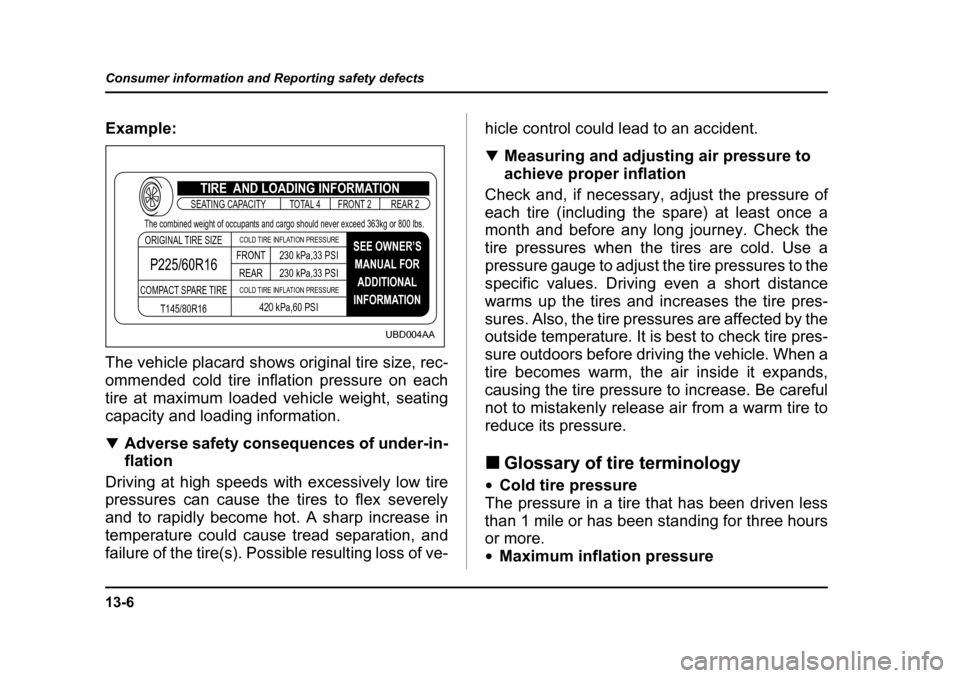
13-6
Consumer information and Reporting safety defects
Example:
The vehicle placard shows original tire size, rec-
ommended cold tire inflation pressure on each
tire at maximum loaded vehicle weight, seating
capacity and loading information. �T
Adverse safety consequences of under-in-
flation
Driving at high speeds with excessively low tire
pressures can cause the tires to flex severely
and to rapidly become hot. A sharp increase in
temperature could cause tread separation, and
failure of the tire(s). Possi ble resulting loss of ve- hicle control could lead to an accident. �T
Measuring and adjusting air pressure to
achieve proper inflation
Check and, if necessary, adjust the pressure of
each tire (including the spare) at least once a
month and before any long journey. Check the
tire pressures when the tires are cold. Use a
pressure gauge to adjust the tire pressures to the
specific values. Driving even a short distance
warms up the tires and increases the tire pres-
sures. Also, the tire pressures are affected by the
outside temperature. It is best to check tire pres-
sure outdoors before driving the vehicle. When a
tire becomes warm, the air inside it expands,
causing the tire pressure to increase. Be careful
not to mistakenly release air from a warm tire to
reduce its pressure. �„ Glossary of tire terminology
�y Cold tire pressure
The pressure in a tire that has been driven less
than 1 mile or has been standing for three hours
or more.�y Maximum inflation pressure
TIRE AND LOADING INFORMATION
SEE OWNER’S
MANUAL FOR ADDITIONAL
INFORMATION
SEATING CAPACITY
ORIGINAL TIRE SIZE
COLD TIRE INFLATION PRESSURE
COLD TIRE INFLATION PRESSURE
FRONT REAR 230 kPa,33 PSI 230 kPa,33 PSI
420 kPa,60 PSI
COMPACT SPARE TIRE
T145/80R16
P225/60R16
The combined weight of occupants and cargo should never exceed 363kg or 800 lbs.
TOTAL 4 FRONT 2 REAR 2
UBD004AA
Page 464 of 487

13-7
Consumer information and Reporting safety defects
– CONTINUED –
The maximum cold inflation pressure to which a
tire may be inflated. �yRecommended inflation pressure
The cold inflation pressure recommended by a
vehicle manufacturer. �y Intended outboard sidewall
1)The sidewall that contai ns a whitewall, bears
white lettering or bears manufacturer, brand,
and/or model name molding that is higher or
deeper than the same molding on the other
sidewall of the tire, or
2)The outward facing sidewall of an asymmet-
rical tire that has a particular side that must al-
ways face outward when mounting on a vehi-
cle.
�y Accessory weight
The combined weight (in excess of those stan-
dard items which may be replaced) of floor mats,
leather seats, cross bars and cargo bed extender
to the extent that these items are available as
factory-installed equipment (whether installed or
not). �y Curb weight
The weight of a motor vehicle with standard
equipment including the ma ximum capacity of fu-el, oil, and coolant and air conditioning. �y
Maximum loaded vehicle weight
The sum of curb weight, accessory weight, vehi-
cle capacity weight and production options weight. �y Normal occupant weight
150 lbs (68 kg) times the number of occupants (2
occupants). �y Occupant distribution
Distribution of occupants in a vehicle, 2 in front. �y Production options weight
The combined weight of those installed regular
production options weighing over 5.1 lbs (2.3 kg)
in excess of those standards items which they
replace, not previously considered in curb weight
or accessory weight. �y Vehicle capacity weight
The total weight of cargo, luggage and occu-
pants that can be added to the vehicle. �y Vehicle maximum load on a tire
Load on an individual tire that is determined by
distributing to each axle its share of the maxi-
mum loaded vehicle weight and dividing by two.
�y Vehicle normal load on a tire
Load on an individual tire that is determined by
Page 465 of 487

13-8
Consumer information and Reporting safety defects
distributing to each ax
le its share of the curb
weight, accessory weight, and normal occupant
weight and dividing by two. �„ Tire care – maintenance and safety
practices
�y Check on a daily basis that the tires are free
from serious damage, nails, and stones. At the
same time, check the tires for abnormal wear. �y Inspect the tire tread regularly and replace the
tires before their tread wear indicators become
visible. When a tire’s tread wear indicator be-
comes visible, the tire is worn beyond the ac-
ceptable limit and must be replaced immediately.
With a tire in this condit ion, driving at even low
speeds in wet weather can cause the vehicle to
hydroplane. Possible resulting loss of vehicle
control can lead to an accident. �y To maximize the life of each tire and ensure
that the tires wear uniforml y, it is best to rotate
the tires every 7,500 miles (12,500 km). Rotating
the tires involves switching the front and rear
tires on the right-hand si de of the vehicle and
similarly switching the fr ont and rear tires on the left-hand side of the vehicle. (Each tire must be
kept on its original side of the vehicle.) Replace
any damaged or unevenly wo
rn tire at the time of
rotation. After tire rotation, adjust the tire pres-
sures and make sure the wheel nuts are correct-
ly tightened. A tightening torque specification
and a tightening sequence specification for the
wheel nuts can be found “Flat tires” section in
chapter 9. �„ Vehicle load limit – how to determine
The load capacity of your vehicle is determined
by weight, not by available cargo space. The
load limit of your vehicle is shown on the vehicle
placard attached to the dr iver’s side B-pillar. Lo-
cate the statement “The combined weight of oc-
cupants and cargo shou ld never exceed XXX kg
or XXX lbs” on your vehicle’s placard.
The vehicle placard also shows seating capacity
of your vehicle.
The total load capacity includes the total weight
of driver and all passengers and their belong-
ings, any cargo, any opti onal equipment such as
a trailer hitch, roof rack or bike carrier, etc., and
Page 466 of 487
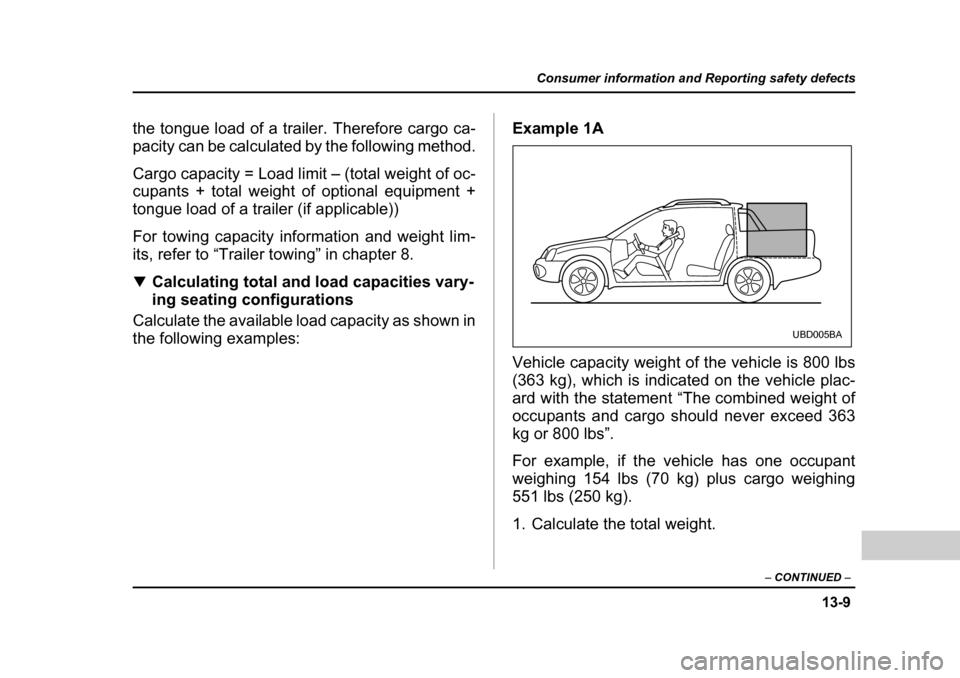
13-9
Consumer information and Reporting safety defects
– CONTINUED –
the tongue load of a trailer. Therefore cargo ca-
pacity can be calculated by the following method.
Cargo capacity = Load limit – (total weight of oc-
cupants + total weight of optional equipment +
tongue load of a trailer (if applicable))
For towing capacity information and weight lim-
its, refer to “Trailer towing” in chapter 8. �T Calculating total and load capacities vary-
ing seating configurations
Calculate the available lo ad capacity as shown in
the following examples: Example 1A
Vehicle capacity weight of the vehicle is 800 lbs
(363 kg), which is indicated on the vehicle plac-
ard with the statement “The combined weight of
occupants and cargo should never exceed 363
kg or 800 lbs”.
For example, if the ve
hicle has one occupant
weighing 154 lbs (70 kg) plus cargo weighing
551 lbs (250 kg).
1. Calculate the total weight.
UBD005BA
Page 467 of 487
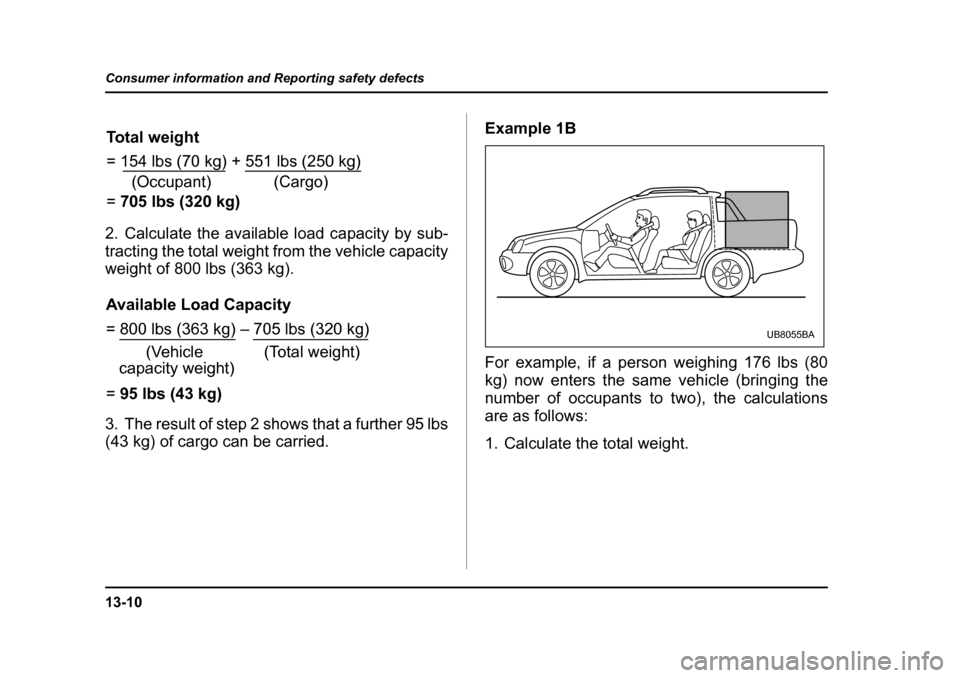
13-10
Consumer information and Reporting safety defects
2. Calculate the available
load capacity by sub-
tracting the total weight from the vehicle capacity
weight of 800 lbs (363 kg).
3. The result of step 2 s hows that a further 95 lbs
(43 kg) of cargo can be carried. Example 1B
For example, if a person weighing 176 lbs (80
kg) now enters the same vehicle (bringing the
number of occupants to two), the calculations
are as follows:
1. Calculate the total weight.
Total weight = 154 lbs (70 kg) + 551 lbs (250 kg) =
705 lbs (320 kg)(Occupant) (Cargo)
Available Load Capacity = 800 lbs (363 kg) 705 lbs (320 kg) =
95 lbs (43 kg) (Vehicle
capacity weight) (Total weight)
UB8055BA
Page 468 of 487
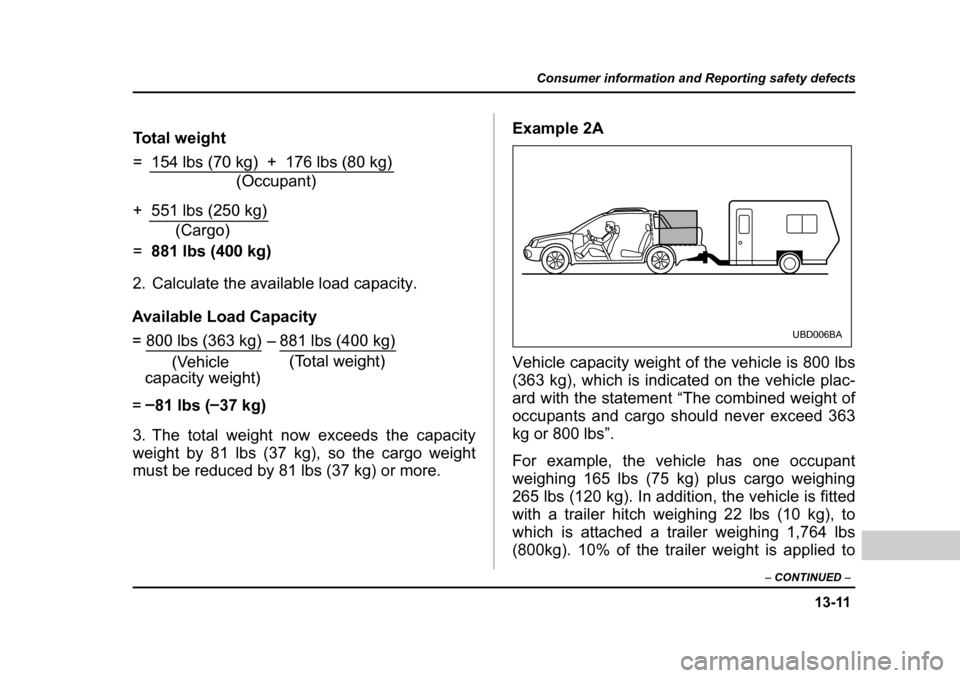
13-11
Consumer information and Reporting safety defects
– CONTINUED –
2. Calculate the available load capacity.
3. The total weight now exceeds the capacity
weight by 81 lbs (37 kg), so the cargo weight
must be reduced by 81 lbs (37 kg) or more. Example 2A
Vehicle capacity weight of the vehicle is 800 lbs
(363 kg), which is indicated on the vehicle plac-
ard with the statement “The combined weight of
occupants and cargo should never exceed 363
kg or 800 lbs”.
For example, the vehicle has one occupant
weighing 165 lbs (75 kg) plus cargo weighing
265 lbs (120 kg). In addition, the vehicle is fitted
with a trailer hitch weighing 22 lbs (10 kg), to
which is attached a trailer weighing 1,764 lbs
(800kg). 10% of the tra
iler weight is applied to
Total weight = 154 lbs (70 kg) + 176 lbs (80 kg) + 551 lbs (250 kg) = 881 lbs (400 kg) (Occupant)
(Cargo)
Available Load Capacity
= 800 lbs (363 kg) 881 lbs (400 kg) = 81 lbs ( 37 kg)(Vehicle
capacity weight) (Total weight)UBD006BA
Page 469 of 487
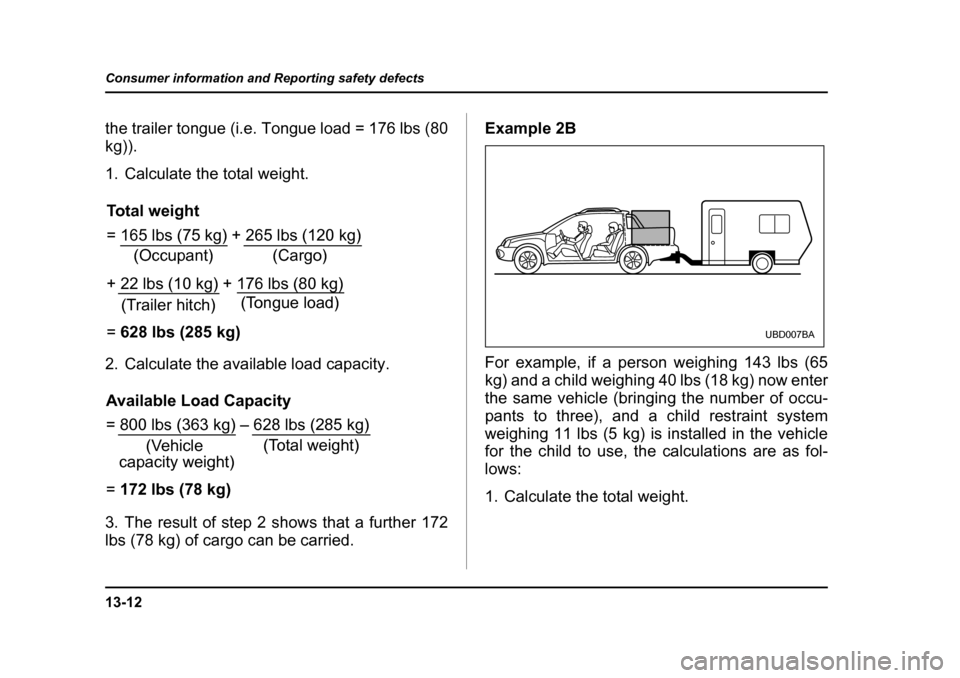
13-12
Consumer information and Reporting safety defects
the trailer tongue (i.e. Tongue load = 176 lbs (80 kg)).
1. Calculate the total weight.
2. Calculate the available load capacity.
3. The result of step 2 shows that a further 172
lbs (78 kg) of cargo can be carried.
Example 2B
For example, if a person weighing 143 lbs (65
kg) and a child weighing 40 lbs (18 kg) now enter
the same vehicle (bringing the number of occu-
pants to three), and a child restraint system
weighing 11 lbs (5 kg) is installed in the vehicle
for the child to use, the calculations are as fol-
lows:
1. Calculate the total weight.
Total weight
= 165 lbs (75 kg) + 265 lbs (120 kg)
+ 22 lbs (10 kg) + 176 lbs (80 kg) =
628 lbs (285 kg)(Occupant) (Cargo)
(Trailer hitch) (Tongue load)
Available Load Capacity = 800 lbs (363 kg) 628 lbs (285 kg) =
172 lbs (78 kg) (Vehicle
capacity weight) (Total weight)
UBD007BA